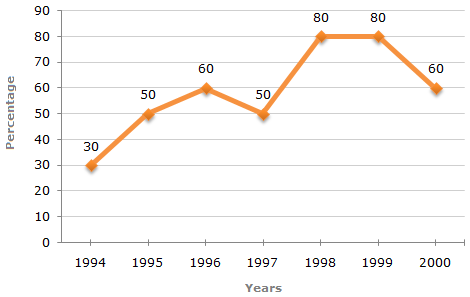|
ANS:D -
Rs. 9000
Let B's capital be Rs. x.
| Then, |
 |
3500 x 12 |
= |
2 |
 |
| 7x |
3 |
 14 x = 126000
 x x = 9000.
|
Each of the questions given below consists of a question followed by three statements. You have to study the question and the statements and decide which of the statement(s) is/are necessary to answer the question.
ANS:C - All I, II and III
I. Material cost = Rs. 2.50 per m2
II. Labour cost = Rs. 3500.
III. Total cost = Rs. 14,500.
Let the area be A sq. metres.
 Material cost = Rs. (14500 - 3500) = Rs. 11,000. Material cost = Rs. (14500 - 3500) = Rs. 11,000.
 |
5A |
= 11000  A = A = |
 |
11000 x 2 |
 |
= 4400 m2. |
| 2 |
5 |
Thus, all I, II and III are needed to get the answer.
 Correct answer is (C).
|
The following line graph gives the percentage of the number of candidates who qualified an examination out of the total number of candidates who appeared for the examination over a period of seven years from 1994 to 2000.
Percentage of Candidates Qualified to Appeared in an Examination Over the Years

|
Directions to Solve
In each question below is given a statement followed by two assumptions numbered I and II. You have to consider the statement and the following assumptions and decide which of the assumptions is implicit in the statement.
Give answer
- (A) If only assumption I is implicit
- (B) If only assumption II is implicit
- (C) If either I or II is implicit
- (D) If neither I nor II is implicit
- (E) If both I and II are implicit.
A
Either I or II is implicit
B
Only assumption I is implicit
C
Neither I nor II is implicit
D
Only assumption II is implicit
E Both I and II are implicit
ANS:B -
Only assumption II is implicit
Explanation:
Sachin's mother has instructed him as a matter of caution and out of care for her child, and not because Sachin himself would not be able to decide. So, I is not implicit. Besides, Sachin's mother instructs him to take to train journey in case it rains heavily. So, II is implicit.
|
A
String str = "She sells sea shells on the sea-shore";
int i, j;
i = str.FirstIndexOf("s");
j = str.IndexOf("s", i + 1);
B
String str = "She sells sea shells on the sea-shore";
int i;
i = str.SecondIndexOf("s");
C
String str = "She sells sea shells on the sea-shore";
int i, j;
i = str.IndexOf("s");
j = str.IndexOf("s", i + 1);
D
String str = "She sells sea shells on the sea-shore";
int i, j;
i = str.LastIndexOf("s");
j = str.IndexOf("s", i - 1);
E
String str = "She sells sea shells on the sea-shore";
int i, j;
i = str.IndexOf("S");
j = str.IndexOf("s", i);
ANS:C -
String str = "She sells sea shells on the sea-shore";
int i, j;
i = str.IndexOf("s");
j = str.IndexOf("s", i + 1);
No answer description is available. Let's discuss.
|
A
suspension cable and anchor cables are attached to a saddle mounted on rollers on top of the pier
B
suspension and anchor cables are fixed to pier top
C
suspension and anchor cables are kept at the same level
ANS:B -
suspension and anchor cables are fixed to pier top
"suspension and anchor cables are fixed to pier top" describes a design configuration in which both the suspension cables and the anchor cables of a suspension bridge are directly attached or anchored to the top of the pier structure.
In a typical suspension bridge design, the suspension cables are the main load-bearing elements that support the bridge deck. They are suspended from tall towers or pylons located on either side of the span. These suspension cables are anchored to massive concrete or steel structures at the ends of the bridge, known as anchorages.
The anchor cables, on the other hand, are attached to the opposite ends of the bridge and are anchored securely into the ground or into large anchor blocks buried deep below the ground level. The anchor cables serve to counteract the tension forces exerted by the suspended bridge deck and help stabilize the structure.
When both the suspension cables and the anchor cables are fixed to the top of the pier, it means that the point of attachment or anchorage for both types of cables is at the uppermost part of the pier structure.
This design configuration can provide stability and structural integrity to the bridge by effectively distributing the loads and forces across the pier and its foundation. However, it may not be as effective in accommodating movement and preventing bending action at the base of the pier compared to designs that incorporate saddles and rollers to allow for cable movement.
|
A
σb = 5 N/mm2, σs = 10 N/mm2
B
σb = 8 N/mm2, σs = 16 N/mm2
C
σb = 10 N/mm2, σs = 20 N/mm2
D
σb = 6 N/mm2, σs = 12 N/mm2
ANS:A -
σb = 10 N/mm2, σs = 20 N/mm2
As it is a compound bar strain produced will be the same in both bars...
PsL/AsEs = PbL/AbL.
L will be cancelled out.
So
Ps/3500*2 = Pb/3000*.1 , Ps/700 = Pb/300.
Or Pb = 0.428ps.
Now P = PB +Ps = 0.428ps +ps = 1.428Ps.
100000=1.428Ps or Ps= 70000N and Pb = 30000N.
Stress = load/ area. stress in steel = 70000/3500 =20N.
Stress in brass = 30000/3000 =10N.
|
ANS:B - 5400 RPM
 .
|
A high gain low BW (Beamwidth)
ANS:A - high gain low BW (Beamwidth)
No answer description is available.
|
ANS:A - 42-50
Triple superphosphate (TSP) is a widely used phosphorus fertilizer. Its composition is primarily phosphorus pentoxide (P2O5), which is derived from phosphate rock. The P2O5 content in TSP usually falls within the range of 42-50%. This means that for every 100 parts of TSP, approximately 42-50 parts are phosphorus pentoxide.
This concentration of phosphorus pentoxide makes TSP an effective source of phosphorus for plants, providing essential nutrients to support their growth and development. The variability in the P2O5 content can depend on factors such as the source of phosphate rock and the manufacturing process.
|







 14
14 Material cost = Rs. (14500 - 3500) = Rs. 11,000.
Material cost = Rs. (14500 - 3500) = Rs. 11,000.
 A =
A =
 Number of candidates qualified in 2000 = (33500 - 21200) = 12300.
Let the number of candidates appeared in 2000 be x.
Number of candidates qualified in 2000 = (33500 - 21200) = 12300.
Let the number of candidates appeared in 2000 be x.
 x =
x =

 .
.